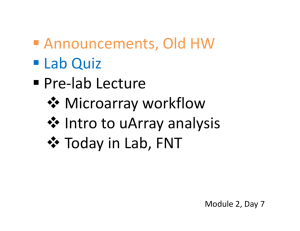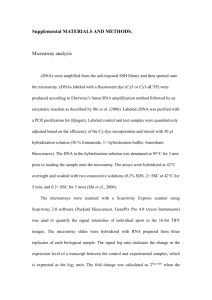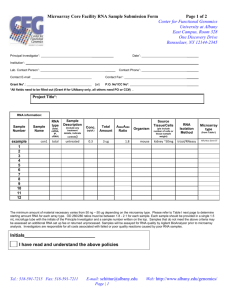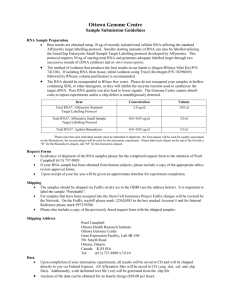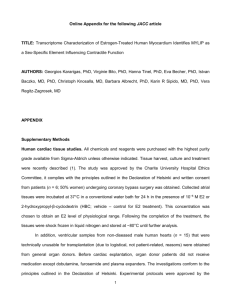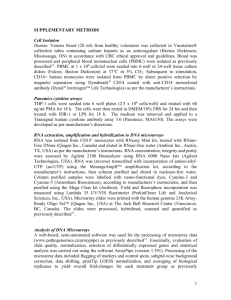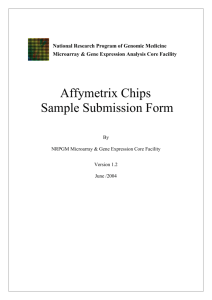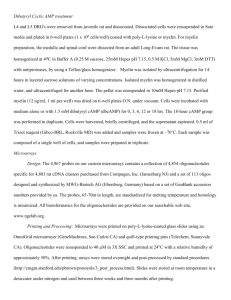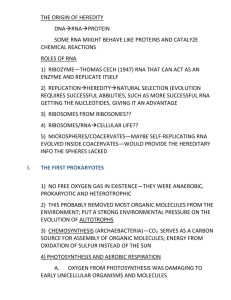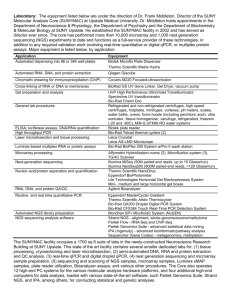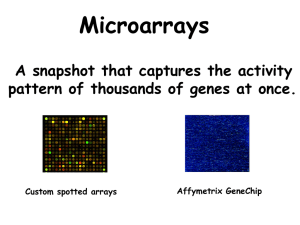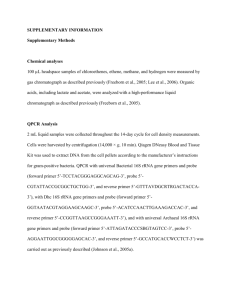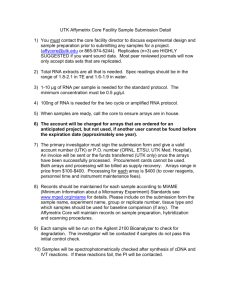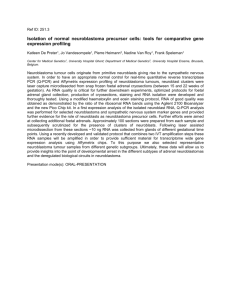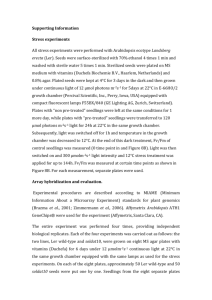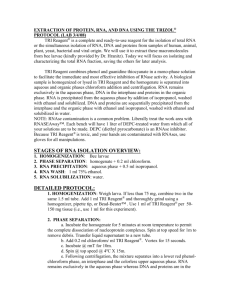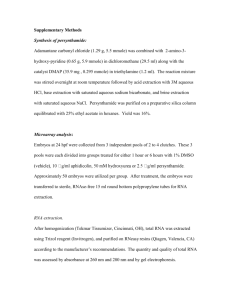Supplemental Materials and Methods Materials and Methods for
advertisement
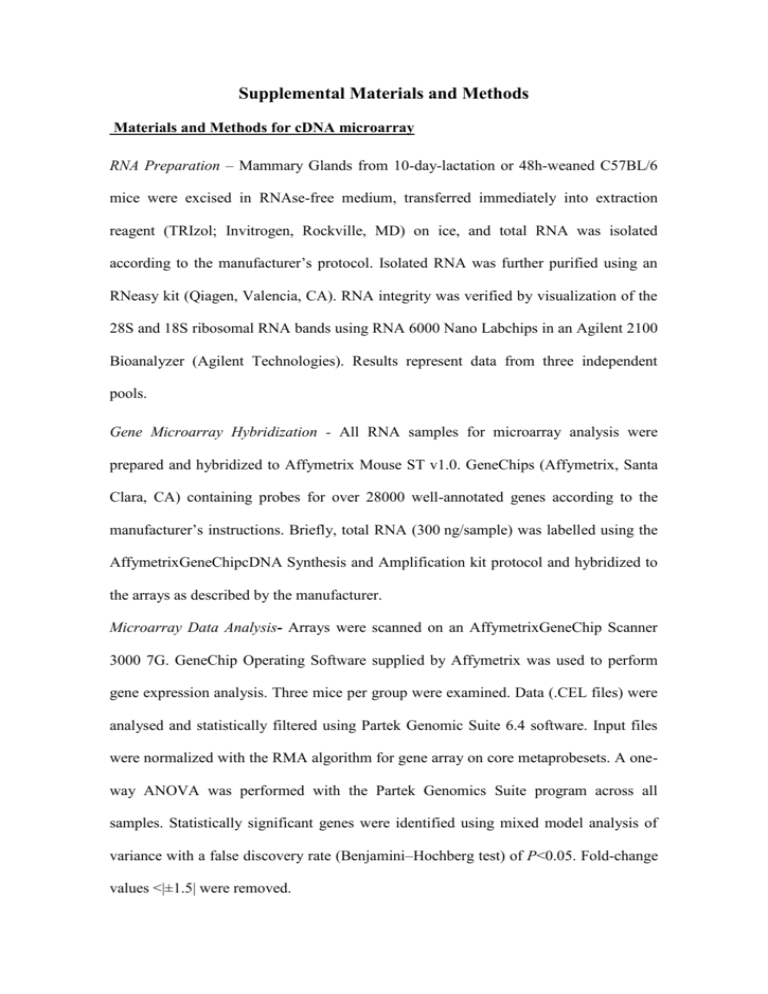
Supplemental Materials and Methods Materials and Methods for cDNA microarray RNA Preparation – Mammary Glands from 10-day-lactation or 48h-weaned C57BL/6 mice were excised in RNAse-free medium, transferred immediately into extraction reagent (TRIzol; Invitrogen, Rockville, MD) on ice, and total RNA was isolated according to the manufacturer’s protocol. Isolated RNA was further purified using an RNeasy kit (Qiagen, Valencia, CA). RNA integrity was verified by visualization of the 28S and 18S ribosomal RNA bands using RNA 6000 Nano Labchips in an Agilent 2100 Bioanalyzer (Agilent Technologies). Results represent data from three independent pools. Gene Microarray Hybridization - All RNA samples for microarray analysis were prepared and hybridized to Affymetrix Mouse ST v1.0. GeneChips (Affymetrix, Santa Clara, CA) containing probes for over 28000 well-annotated genes according to the manufacturer’s instructions. Briefly, total RNA (300 ng/sample) was labelled using the AffymetrixGeneChipcDNA Synthesis and Amplification kit protocol and hybridized to the arrays as described by the manufacturer. Microarray Data Analysis- Arrays were scanned on an AffymetrixGeneChip Scanner 3000 7G. GeneChip Operating Software supplied by Affymetrix was used to perform gene expression analysis. Three mice per group were examined. Data (.CEL files) were analysed and statistically filtered using Partek Genomic Suite 6.4 software. Input files were normalized with the RMA algorithm for gene array on core metaprobesets. A oneway ANOVA was performed with the Partek Genomics Suite program across all samples. Statistically significant genes were identified using mixed model analysis of variance with a false discovery rate (Benjamini–Hochberg test) of P<0.05. Fold-change values <|±1.5| were removed. Calcium quantification For quantification of the calcium content within the mammary gland a colorimetric assay kit (Biovision, CA, USA) was used. Briefly, mammary tissue was minced, washed and lysated in PBS using a Dounce homogenizer. 25 μL of this lysate were used for the assay in a 96-well plate; 90 μL of the chromogenic reagent (o-cresolphthalein) and 60μL of buffer reagent were then added to each well, and the plate was incubated for 10 minutes at room temperature. A standard curve was generated using serial dilutions of CaCO3 (0-1.5 mg/dL), and the absorbance of each well was then measured using a microplate reader at 575 nm. Proteomics studies The DeCyder (v. 6.5) software tools (GE Healthcare) were used for image analysis. The DIA (differential in-gel analysis) module was used to align and normalize images within each gel. Spots with slopes > 1.1, areas < 100, volumes < 10,000 and peak heights < 100 were excluded. For comparative pair-wise analyses of gel features across different physical gels, the DIA data sets were analyzed using the BVA (biological variation analysis) module. Spots were excised robotically (ProPic, Genomic Solutions) using a triangulation algorithm implemented with in-house software. LC-ESI-MS/MS analysis. The gel pieces were digested in situ with trypsin (12.5 ng/l trypsin for 12 h at 37º C). MS/MS analysis was performed as previously described [Muñoz et al. 2008]. Microcapillary reversed phase LC was performed with a CapLC TM (Waters) capillary system. Reversed phase separation of tryptic digests was performed with an Atlantis, C18, 3 m, 75 m x 10 cm Nano EaseTM fused silica capillary column (Waters) equilibrated in 5% acetonitrile, 0.2% formic acid. After injection of 6 l of sample, the column was washed for 5 min with the same buffer and the peptides were eluted using a linear gradient of 5-50% acetonitrile in 45 min at a constant flow rate of 0.2 l/min. The column was coupled online to a Q-TOF Micro (Waters) using a PicoTip nanospray ionization source (Waters). The heated capillary temperature was 80º C and the spray voltage was 1.8-2.2 kV. MS/MS data were collected in an automated datadependent mode. The three most intense ions in each survey scan were sequentially fragmented by collision-induced dissociation (CID) using an isolation width of 2.0 and relative collision energy of 35 V. Data processing was performed with MassLynx 4.1. Database searching was carried out with ProteinLynx Global Server 2.1 (Waters) and Phenyx 2.2 (GeneBio, Geneva, Switzerland) against Uniprot knowledgebase Release 12.3 consisting of UniprotKB/Swiss-Prot Release 54.3 and UniprotKB/TrEMBL Release 37.3 with 285.335 and 4.932.421 entries, respectively. The search was enzymatically constrained for trypsin and allowed for one missed cleavage site. Further search parameters were as follows: no restriction on molecular weight and isoelectric point; fixed modification, carbamidomethylation of cysteine; variable modification, oxidation of methionine. Data were then manually inspected and the results were only accepted when the Mr and pI of the identified protein were coincident with the electrophoretic mobility of the corresponding spot on 2D.

